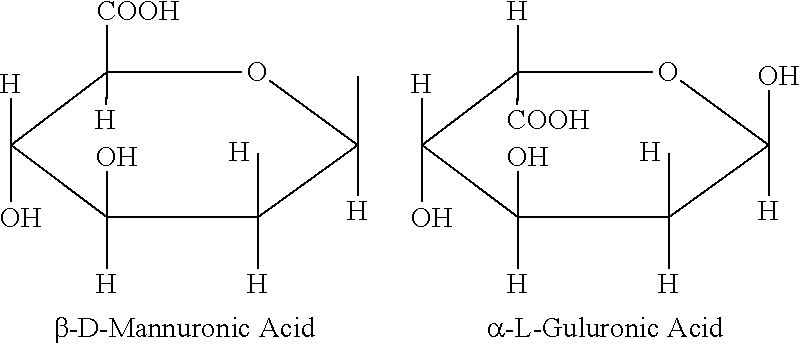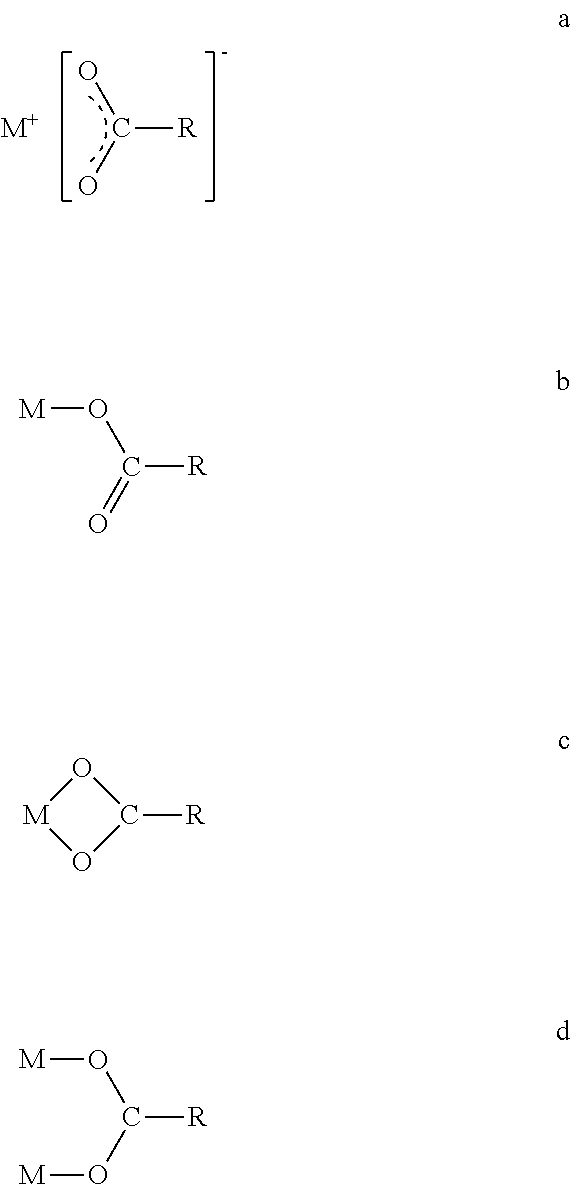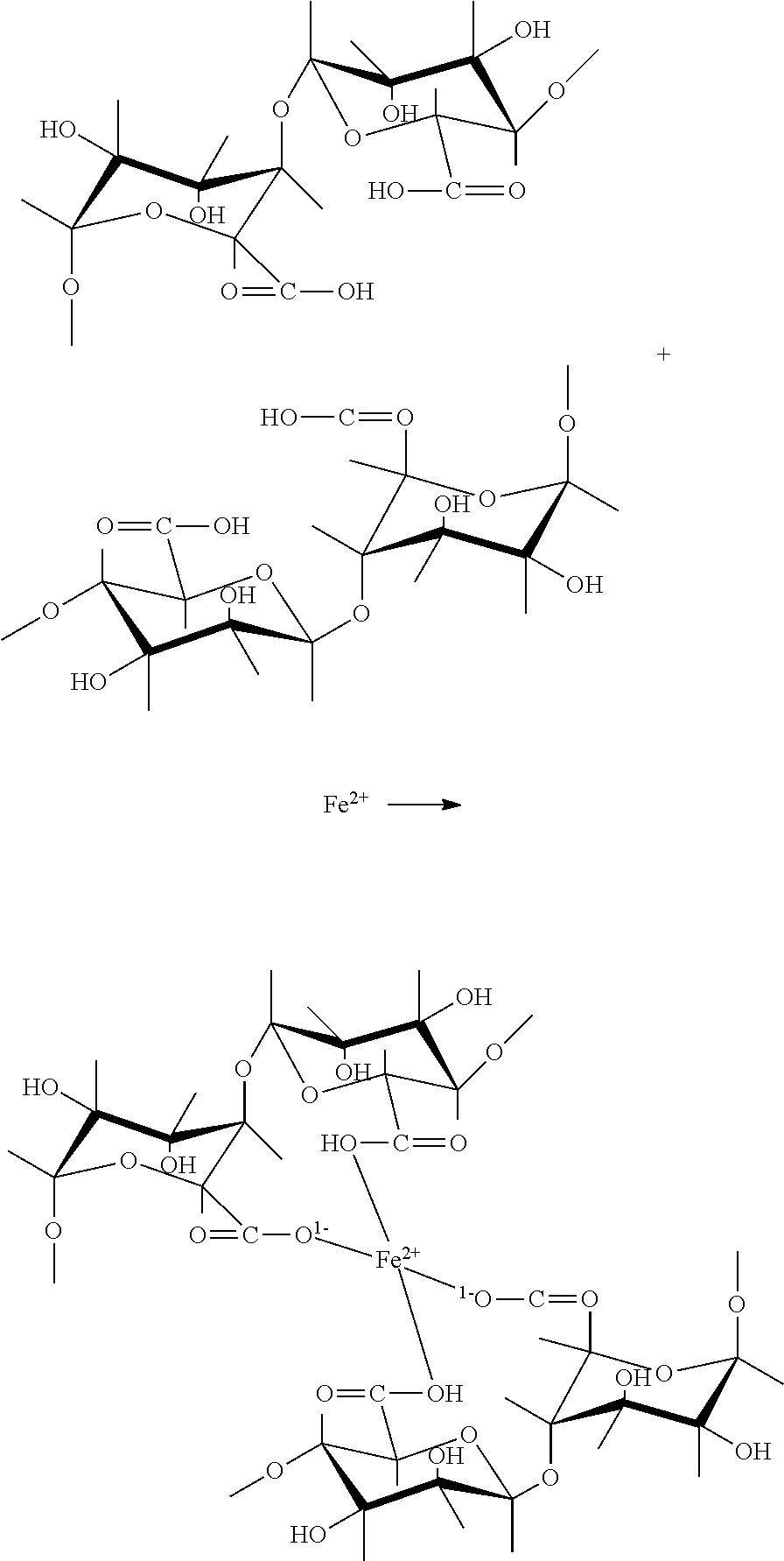Iron-Functionalized Alginate for Phosphate and Other Contaminant Removal and Recovery from Aqueous Solutions
a technology of iron-functionalized alginate and phosphate, which is applied in the direction of water/sewage treatment by ion exchange, quary waste water treatment, application, etc., can solve the problems of deterioration of water quality, nzvi coating, eutrophication of water bodies, etc., and achieve the effect of increasing the nutrient content of soil
- Summary
- Abstract
- Description
- Claims
- Application Information
AI Technical Summary
Benefits of technology
Problems solved by technology
Method used
Image
Examples
example 1
Aqueous Phosphate Removal Using Iron-Functionalized Alginate
[0056]Iron (II) cross-linked alginate (FCA) biopolymer (referred to more generally herein as “iron-functionalized” alginate, or “FFA”) was synthesized and investigated for phosphate removal. Phosphate was completely removed from water using the FCA beads in 12 h (C0=5 mg PO43−-P / L). The second order reaction model fitted well for the reaction and reaction rate constants were found to be 0.771 and 2×10−4 per h for 5 and 100 mg PO43−-P / L, respectively. Interference of Cl−, HCO3−, SO42−, NO3− and natural organic matter (NOM) were investigated and no change in the removal efficiency of phosphate was observed. Maximum adsorption capacity was calculated as 14.77 mg / g of dry beads, and the experimental data were found to most closely fit Freundlich isotherm (R2=0.9078). On electron microscopic examination, nanoparticles with average size of 83.65±42.83 (n=67) were observed inside the beads. For comparison purposes calcium cross-li...
example 2
Compositional Analysis of Iron-Functionalized Alginate Beads
[0114]Compositional analysis was performed on dry FFA beads before and after sorption of phosphate. FIGS. 11 and 12 show SEM / EDS images of cross sections of dry FFA beads. Beads were dried using a vacuum oven under an N2 environment. FIG. 11 shows SEM / EDS images of cross sections of new dry FFA beads (before sorbing phosphate). FIG. 12 shows SEM / EDS images of cross sections of spent dry FFA beads (after sorbing phosphate).
Results for Fresh FFA Beads (Before Sorbing Phosphate)
Weight %
[0115]
C-KO-KCl-KCa-KFe-L125559 NEW ALGINATE DRY XSECT(1)_pt124.7415.6428.040.5631.02125559 NEW ALGINATE DRY XSECT(1)_pt227.0914.0732.130.6026.11125559 NEW ALGINATE DRY XSECT(1)_pt333.709.7641.930.7313.88
Carbon24-38%Fe13-31%
Results for Used FFA Beads (after Sorbing Phosphate)
Weight %
[0116]
C-KO-KP-KK-KCa-KFe-L125560 USED ALGINATE DRY XSECT(2)_pt125.2727.166.283.4137.88125560 USED ALGINATE DRY XSECT(2)_pt222.2126.946.383.380.5540.54125560 USED ALGI...
example 3
Crosslinked Alginates
[0117]The use of a number of biopolymers like alginate, poly(methyl methacrylate) (PMMA), chitosan, and carrageenan have been explored for environmental remediation applications (Bezbaruah et al., 2009; Bezbaruah et al., 2011).
[0118]Alginate is a biopolymer derived from seaweeds, and it has been used for entrapment for microbial cells and NZVI (Bezbaruah et al., 2009, Kim et al., 2010). The entrapped NZVI was found to work very efficiently for contaminants like trichloroethylene (TCE). The entrapment process does not require sophisticated instrumentation and can be performed at ambient temperature and pressure. Ca-alginate is non-toxic, biodegradable, and sparsely soluble in water making it an ideal polymer for use in environmental applications (Bezbaruah et al., 2009a). The porous nature of Ca-alginate allows solutes to diffuse and come in contact with the entrapped NZVI (Bezbaruah et al., 2009).
[0119]Ionic cross-linking refers to the ion exchange process betwe...
PUM
| Property | Measurement | Unit |
|---|---|---|
| diameter | aaaaa | aaaaa |
| diameter | aaaaa | aaaaa |
| diameter | aaaaa | aaaaa |
Abstract
Description
Claims
Application Information
 Login to View More
Login to View More - R&D Engineer
- R&D Manager
- IP Professional
- Industry Leading Data Capabilities
- Powerful AI technology
- Patent DNA Extraction
Browse by: Latest US Patents, China's latest patents, Technical Efficacy Thesaurus, Application Domain, Technology Topic, Popular Technical Reports.
© 2024 PatSnap. All rights reserved.Legal|Privacy policy|Modern Slavery Act Transparency Statement|Sitemap|About US| Contact US: help@patsnap.com










